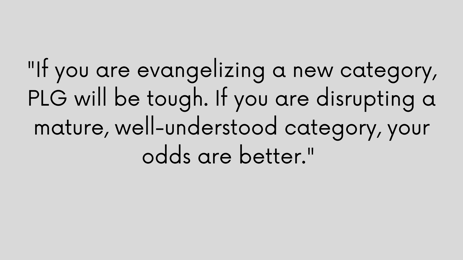Many startup experts believe PLG is the next business model innovation to disrupt the B2B software ecosystem.
I completely agree.
%20(1).png?width=446&name=PLG%20Considerations%20%20(Blog%20Banner)%20(1).png)
As we entered this decade, the SaaS disruptors have dominated the public markets in almost every B2B software category. PLG has the same disruptive potential. I mentioned in my PLG Playbook that I predict today’s seed stage PLG innovators will replicate the SaaS disruption movement and dominate the public markets in 2027, but with one important difference.
PLG does not apply to as broad a set of B2B software categories as SaaS does.
That leaves the critical question. Is PLG applicable to your business category? If not, keep going. If so, adopt and disrupt, or be disrupted.
How should you assess whether PLG is applicable to your startup’s category? Here are six factors to help with your evaluation.
.png?width=1200&name=PLG%20Considerations%20(LinkedIn).png)
CONSIDERATION #1: Low time and effort to retainable value
This consideration says a lot in a few words, so let me elaborate on the meaning of each.
- Low time: Users experience value in minutes
- Low effort: Users realize the value with little work on their part
- Retainable value: The value use case is on-going rather than one-time
Product adoption without human assistance is a fundamental principle of PLG. Product categories that take a lot of effort to set up and adopt and/or take a long time for the user to see value are less conducive to PLG. For example in the HR sector, PLG is a better fit for a product that monitors the happiness of the employee base each week versus a one that serves as the system of record for employee status, pay, and benefits.
Another core attribute of PLG is “adopt-before-buy”. PLG re-orders the typical buying journey. With users getting access to product value before purchasing, the value needs to be recurring versus one-time. An example product that has low time and effort but does not have retainable value is Website Grader, a tool we developed in the early days of HubSpot. Website Grader allowed users to enter their URL and within 90 seconds generated a 5 page report on how to improve the optimization of the website for search engines. Once the report was generated, there was very little motivation for the user to return to the site or to convert to a paying subscriber to Website Grader. While the site served as an amazing lead generator for us, the nature of the lead behaved much more like a Marketing Qualified Lead (MQL) generated from a piece of content like an eBook than a Product Qualified Lead (PQL) generated from an application used regularly by the user.
CONSIDERATION #2: Product value proposition conveyed in a digital ad
In a PLG acquisition model, not only does the user need to adopt the product without a human assistant. They also need to understand the value of the product without human assistance.

Value propositions conveyed in a simple, concise medium, such as a digital ad, social media post, or email subject line, work well for PLG. If you are evangelizing a new category, PLG will be tough. If you are disrupting a mature, well understood category, your odds are better.
Applying PLG to an existing category has another advantage. Just like it was difficult for the on-premise incumbents to transition to SaaS to avoid disruption, it is also difficult for non-PLG incumbents to transition to PLG.
CONSIDERATION #3: Primary value created for the end user versus the company
PLG works best when the person deciding to adopt the product is the same as the person who will ultimately use it. For example in the sales tech sector, a product for VPs of Sales to improve forecasting would be difficult for PLG. In order to realizethis value, the VP of Sales needs to get the salespeople to adopt the product. Value is created for the VP. The salesperson is the end user. A non-PLG motion like MQL/inside sales or ABM/ABS targeting the VP of Sales is more optimal here. On the other hand, a product that automatically enriches a sales contact with demographics, firmographics, news, and other information would be conducive to PLG. The person that decides to adopt the product can be the same as the person that receives value from the product.
CONSIDERATION #4: Pricing and packaging that monetizes the company versus the end user
.png?width=465&name=PLG%20quote%20(1).png)
Consumption models that allow a certain threshold of free adoption, such as seats, contacts, gigabytes, etc., and then asks the user to pay once a certain consumption threshold is reached are common in the PLG ecosystem. However, a pricing and packaging model that allows unlimited free usage for the end user and monetizes using enterprise features that the company primarily cares about is better for PLG.
Why?
This pricing and packaging model makes it more difficult for new entrants to disrupt. When a company does not have a sustainable advantage, new entrants can simply undercut their price to compete and win. A consumption threshold presents the same opportunity. A new entrant can simply offer a higher threshold to compete and win. However, keeping the end user utilization unlimited and free raises the number of users within a company, in turn increasing the switching cost and creating a context where the company is willing to pay a higher fee for enterprise features because the switching cost is so high.
Let’s look at the backup and storage category to illustrate this situation. Company 1 monetizes the end user rather than the company. They offer free storage up to 1 GB but charges the user per GB thereafter. Company 2 offers unlimited usage to the end user and monetizes the company. They offer unlimited free storage to the end user and charge the company for user admin, tech stack integration, SOX compliant security levels, and other enterprise features. End users naturally adopt Company 2 with unlimited storage. More adoption by end users means more switching cost for the employer of these users. The CIO of this employer is willing to pay a higher price for access to the enterprise features because of the switching cost created.
CONSIDERATION #5: Single player mode
When a user can extract value from the product without dependency from others (I.e. single player mode), the category is more conducive to PLG. If value is dependent on others adopting the product, success of PLG is more difficult. Dependency on multiple adopters creates more decision makers and more friction. That said, as end users become more comfortable with adopting products through a PLG motion, opening use cases requiring multiplayer modes, such as project management software and team collaboration software, have become feasible. However, if there is an option in your business category to start with either a high value single player use case or a high value mufti-player use case, the former option is easier. Take, for example, a time management application. Executing PLG will be easier with an opening use case that helps an individual manage their time better versus a use case attempting to coordinate time across an entire team.
CONSIDERATION #6: Low free user CAC and Gross Margin
The “adopt-before-buy” nature of PLG means the paying customers not only need to offset the cost to acquire (CAC) and serve (Gross Margin) these paying customers but also cover the entire cost of acquiring and serving the free users. This formula is easier to pull off when the cost to acquire and serve free users is low.
One factor driving the potential for low free user CAC is the number of user targets in the Total Addressable Market, or TAM. If the business category has a small number of user targets, like selling to CTOs of Fortune 1000 executives in the telecom sector, a low free user CAC will be difficult to pull off. On the other hand, solutions targeting TAMs with a large number of end user targets, such as developers working at SMB and mid-market tech companies, are more conducive to this opportunity.
Another factor driving low free user CAC is the demand generation channels that the target end users respond to. User acquisition methods like content marketing and virality have much higher potentials for low free user CAC than acquisition methods like ABM/ABS and cold calling. The former methods work well when targeting, for example, small business owners. That latter methods are often required when targeting, for example, enterprise executives.
The low gross margin preference is accommodated by most software categories. However, this constraint makes PLG difficult to apply outside of software, such as hardware or services businesses.
I hope this list of evaluation criteria helps with your strategic decision making process. What I find most fun and exciting about PLG is, like SaaS in the early 2000s, we are still figuring it out. So, what did I miss?

.png?width=760&height=550&name=PLG%20Blog%20Header%20(1).png)

